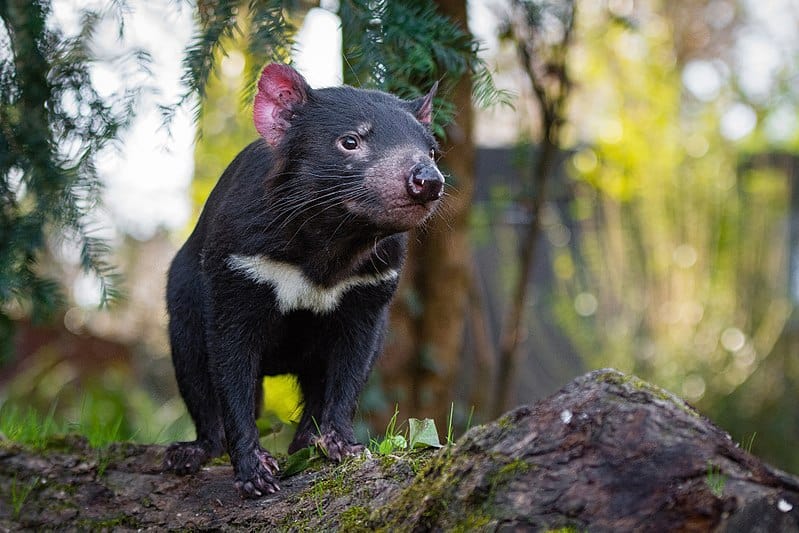
Tasmanian Devil Facts
- The Tasmanian Devil long ago became a symbol of aggressiveness and savage behavior in many of the world’s cultures. While fact often becomes mistaken for fiction, in this case symbolism is indeed based in fact. That’s because it tends to have an extremely aggressive nature.
- The impressive creature also represents a most unusual type of animal. That holds true because the remarkable creation of Nature and evolution classifies as a carnivorous marsupial mammal. The amazing animal also presently ranks as the largest such species still in existence.
- Within the scientific community, it’s perhaps much better known by its technical designation. That’s the difficult to pronounce appellation Sarcophilus harrisii. It received this particular moniker due to the efforts of the noted French researcher, Pierre Boitard, in the year 1841.
- Sadly, however, the Tasmanian Devil may not hold that particular distinction for much longer. It once appeared as highly numerous throughout a comparatively wide range of habitation. The wonder now exists almost exclusively in only one very isolated location in the world.
- Its population numbers dwindled dramatically during the 19th and early 20th centuries, though. But the unique mammal finally became a legally protected species in the year 1941. Consequently, the population of the species slowly began to recover, at least for a short period.
- Beginning in 1996, a new, and serious threat emerged. At that time, a bizarre disease began to ravage the population. Causing severe facial tumors, it eventually prevents feeding, and leads to starvation. Due to this, the IUCN now lists it as Endangered on its published Red List.
Related Articles
Tasmanian Devil Physical Description
The captivating Tasmanian Devil never fails to capture the immediate interest and attention of those fortunate enough to encounter one in the wild. It does so, however, due more to its impressive nature than sheer size. That’s because, though the largest of its kind, it’s still small.
Like many of the wondrous fauna around the world, it follows a specific pattern of natural development. That’s the fact that it displays a certain degree of the physiological characteristic known as sexual dimorphism. In its case, though, this manifests only to a fairly moderate degree.
That naturally occuring developmental trait appears in terms of pure physical size. The males of this biological marvel attain slightly greater measurements than that of their female counterparts. In this respect, the animal follows the pattern common among many known mammalian species.
These very same males usually develop a head-and-body length equaling roughly 25.7 in (65.2 cm). Meanwhile, the tail of the fascinating creature averages a length totaling roughly 10.2 in (25.8 cm). In terms of weight, the males of the well-known species generally average about 18 lb (8.16 kg).
Yet the females of the remarkable species usually only reach about 22 in (57 cm) in head-and-body length. The same female individuals also develop a tail averaging 9.6 in (24.4 cm) in length. But, in terms of body mass, these same females only typically reach a weight of about 13.2 lb (6 kg).
Intriguingly, in both genders the front legs grow somewhat longer than the rear legs. This typically gives the Tasmanian Devil a distinctive gait. Additionally, the fur usually presents mainly black. Uneven white spots or splotches also sometimes appear on the rump and chest of the mammal.
- Kingdom: Animalia
- Phylum: Chordata
- Class: Mammalia
- Order: Dasyuromorphia
- Family: Dasyuridae
- Genus: Sarcophilus
- Species: S. harrisii
Tasmanian Devil Distribution, Habitat, and Ecology
The breathtaking Tasmanian Devil evolved as indigenous to only a comparatively small and restricted portion of the surface of the earth. Precisely where that zone of habitation lies won’t surprise many people. That’s true since it developed as mainly native to the island of Tasmania.
In past times, however, it also appeared in another nearby location. That’s the mainland section of the equally stunning continent of Australia. Presently, these awesome creatures in only one other location in the wild. That’s a tiny island joined to Tasmania only during times of high tide.
Within that limited range, however, the intrepid mammal proves itself to be highly adaptable in nature. As a result, it presently lives within every type of habitat on the island. This often includes outlying portions of urban areas. This tendency, however, often proves to be to its detriment.
This carnivore also evolved as both nocturnal and crepuscular in nature. The prey of the Tasmanian Devil sometimes includes animals as large as small kangaroos. Nevertheless, it most commonly prefers to hunt smaller prey, though. Being opportunistic, it usually eats carrion more than it hunts.
Breeding season typically occurs during the months of March to May. Following mating, the females generally give birth to an astonishing 20 -40 young! Lamentably, though, only 4 – 6 survive on average, due to the presence of a limited number of teats within the pouch of the mother.
Uncommonly, its reputation for aggressive behavior actually remains quite well deserved. That holds true due to the fact that, mainly living a solitary life, except for mating, the males often fight quite savagely in encounters. Even its mating habits have been referred to as extremely vigorous.
Species Sharing Its Range
Check out our other articles on Earth’s Extremely Threatened Flowers, Giant Trevally, Plitvice Lakes, Socotra Bluet, Spider Tailed Viper, Puffin, Bornean Flat Head Frog, Maned Wolf
